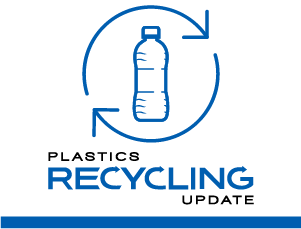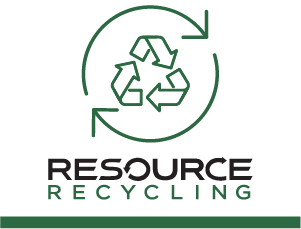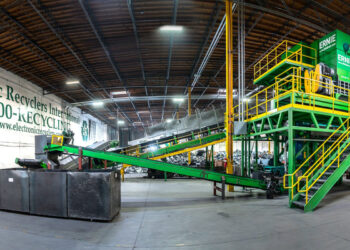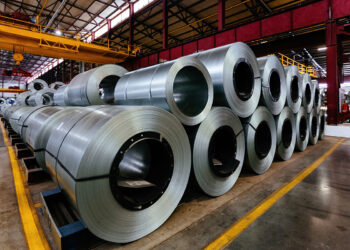This article appeared in the 2025 issue of E-Scrap News. Subscribe today for access to all print content.
Increased interest in securing domestic supplies of critical minerals is resulting in a recent wave of innovative projects across the US, turning old electronics into a new source of rare earth elements (REE).
“Domestic policy and funding are supporting the increase in capacity that has never been seen before in the United States for recycling, processing and refining critical minerals to meet projected demand over the next decades for metals such as lithium, cobalt, nickel, etc.,” said Danielle Spalding, vice president of public affairs at Wixom, Michigan-based Cirba Solutions, which is extremely active in battery and electronics recycling, recovering critical minerals from complex waste streams.
From hard drive magnets pulled out of data centers to many companies experimenting with pulling REE from e-scrap, today’s recyclers, manufacturers and research institutions are rapidly scaling efforts to reclaim neodymium and other key materials once considered out of reach.
The reason? Supply chain vulnerabilities, geopolitical tensions and surging demand for clean energy technologies have made rare earth recovery from e-scrap not just an environmental opportunity but a strategic priority.
Those factors are why rare earth recovery has become more mainstream within the electronics recycling field. In just the past year, a series of high-profile initiatives have signaled growing momentum: Apple and MP Materials inked a landmark agreement to process magnets from retired devices; Metallium is constructing a Texas facility designed to extract rare earths and other critical minerals from e-scrap; Indianapolis-based RecycleForce is piloting recovery inside an active recycling plant with support from a national laboratory; and HyProMag has partnered with Intelligent Lifecycle Solutions to secure steady hard drive magnet feedstock for a new U.S. plant.
September’s Electronics Sustainability Conference even held one of its main sessions on the topic, showing how industry leaders now view rare earth recovery as both a business opportunity and a strategic necessity.
Opportunities for rare earth recovery
When it comes to recycling REE, not all electronics are created equal. While some devices contain concentrated, easily accessible sources of REE, others make recovery far more complex and inefficient.
Sally Tran of the Electronic Recycling Association noted that while its primary focus is on extending the life cycle of electronics through reuse, refurbishment and donation before recycling, it works closely with certified downstream recycling partners who handle the responsible processing of end-of-life devices, including the recovery of metals such as neodymium from hard drive magnets.
“We actively share industry updates, best practices, and opportunities with our partners to encourage the adoption of advanced recovery methods,” she said. “We have seen a gradual increase in interest from our network, particularly as the demand for sustainable sourcing and the circular economy grows. However, the specialized nature of REE recovery means that many organizations are still in the exploration stage.”
Pragathi Darapaneni, Ph.D., senior materials scientist with more than 14 years of experience in rare-earth-free material innovation, surface engineering and sustainable energy technologies, noted high-grade neodymium-iron-boron (NdFeB) magnets from hard drives, wind turbine generators and MRI machines are among the best recovery opportunities as they have high REE concentration and relatively standardized form factors.
“On the other hand, phosphor powders from fluorescent lamps and LEDs are more challenging because REEs are dispersed in a complex chemical matrix and often contaminated with mercury or other heavy metals,” she said. “Miniaturized electronics, such as smartphones, contain REEs in smaller, more scattered quantities, making recovery less economical without high-throughput automated disassembly.”
Pini Althaus, co-founder and CEO of New York-based REEMAG, which recycles end-of-life magnets by use of low-energy electrochemicals that separate the magnet at its grain boundaries, keeping the NdFeB crystal phase intact, noted this method recovers a powder that can go straight back into high-performance magnets.
“Every batch is tested for phase purity, oxygen content, particle size and magnetic performance,” he said. “Independent labs have shown our recycled powder matches the coercivity and remanence of commercial N35–N44 grades. By preserving the original alloy structure, we give manufacturers a material that presses, sinters and performs just like virgin feedstock, often without the need for blending.”
The result is less energy, zero chemical waste and a direct “magnet-to-magnet” pathway that closes the loop considerably faster than conventional routes.
“Moving from single units to 35-kilogram batch modules was about more than turning up the dial,” Althaus said. “We had to engineer oxygen control, refine particle size management and design rinse and drying stages that worked at scale. The process now consistently handles mixed and coated feedstock, materials most recyclers reject, without costly pretreatment. Stable output at batch level means we’re now firmly in pilot production territory, with a clear line of sight to multi-module, commercial-scale deployment.”
The company sources its end-of-life magnets from a broad base: hard drives and speakers from e-waste streams, large-format magnets from industrial motors and EV drive units and decommissioned wind turbine rotors.
“Thanks to our ability to process glued, coated, and commingled magnets, we can take in cheaper, more abundant scrap, cutting feedstock costs while securing volume,” Althaus said.
Over the next year, REEMAG is moving from pilot to production with a 1,000-metric ton/year modular facility and active offtake talks in wind, electronics and automotive.
“To secure feedstock and boost resilience, we’re building partnerships in India, the United Arab Emirates and other strategic markets,” Althaus said. “Our next stage isn’t just about capacity, it’s about intelligence. A new digitized circular supply chain will map feedstock material flows across geographies, with blockchain traceability, carbon accounting and real-time logistics optimization.”
Key material and separation challenges
Recovering REE from discarded electronics is challenging because they are deeply embedded in complex materials and tightly bound with other elements, so extraction and purification cause issues.
“The main challenge is that REEs are almost never present in pure form — they’re embedded in alloys, magnets, phosphors or glass, and tightly bonded with other elements,” Darapaneni said. “Separating them requires breaking down complex, multi-material assemblies without losing material in the process. In permanent magnets, for example, neodymium and dysprosium are alloyed with iron and boron, making selective separation chemically demanding.”
The Electronic Recycling Association noted the big issues its partners report include the high cost of specialized recovery equipment, the complexity of dismantling certain components and the limited availability of economically viable processing options in North America. Logistics, material contamination and scale also present operational hurdles.
Chemical solutions
More recently, emerging chemical and electrochemical leaching techniques are opening new pathways to tackle the intricate mix of metals, coatings and polymers in electronic waste, offering more selective and efficient ways to extract rare earth elements.
“Traditional hydrometallurgical processes use strong acids to dissolve REEs, but they produce large volumes of hazardous waste and lack selectivity,” Darapaneni explained. “Newer methods use tailored ligands, ionic liquids or bioleaching to selectively bind REEs while leaving base metals behind. Electrochemical leaching allows for in-situ control of dissolution potential, minimizing co-dissolution of contaminants. These innovations can process mixed waste streams with lower chemical consumption, reduced secondary waste and higher selectivity, improving both environmental and economic feasibility.”
The coating challenge
Surface treatments and protective coatings can either act as barriers that trap rare earth elements inside devices or, when designed with recyclability in mind, help streamline their recovery. Many components are coated, plated or encapsulated in epoxy, which can resist processing.
Contamination from base metals, plastics and solders further complicates separation and purity control.
Surface coatings such as nickel plating on magnets or polymer encapsulation in sensors can significantly hinder recovery by adding extra processing steps for stripping or thermal decomposition, Darapaneni noted, explaining these layers must be removed before chemical leaching to avoid contamination.
“On the enabling side, some emerging designs use sacrificial or water-soluble coatings that dissolve under mild conditions, exposing REE-rich materials without harsh pretreatment,” she said. “Strategic surface engineering during manufacturing could make end-of-life disassembly and separation far more efficient.”
Possible game-changers to increase e-scrap REE recovery
Experts in the industry are seeing a host of breakthrough technologies and federal initiatives that could help to transform rare earth extraction from electronic scrap into a scalable, efficient process.
For instance, the US Department of Energy’s Critical Materials Institute has been driving research into magnet-to-magnet recycling, where NdFeB magnets are directly reprocessed into new ones without fully separating REEs into oxides.
Projects at Ames Laboratory and Oak Ridge National Laboratory are also exploring membrane-based separations and plasma processing, which could dramatically cut chemical use.
On the industrial side, companies like Urban Mining Co. and USA Rare Earth are scaling automated disassembly and short-loop recycling to capture REEs before they’re lost to shredding.
Spalding noted that currently, the U.S. is heavily reliant on foreign sources for critical minerals, making us vulnerable to volatile market prices and disruptions to supply chains.
“To reduce this dependency, we need to prioritize diversifying our supply chains, and one way to do this is to increase US capacity to recycle end-of-life batteries to extract critical minerals to be put back into the domestic supply chain,” she said. “By repositioning ourselves as a leading producer of critical minerals, we can reduce the nation’s mineral reliance on China and other foreign entities, strengthen our domestic manufacturing capabilities, and enhance national security and global competitiveness.”
Looking ahead, future electronics could be engineered with rare earth recovery in mind, using modular designs and green electronics principles to make extraction simpler, cleaner and more efficient.
“Design for Disassembly will be critical using modular assemblies, standardized fasteners and minimal adhesive bonding, making it far easier to extract REE-containing components intact,” Darapaneni said. “Clearly labeling and mapping REE content in components could also streamline sorting. Where possible, replacing permanent bonding with reversible mechanical fixtures allows for direct component reuse or targeted material recovery.”
Collaboration between recyclers, technology providers and government agencies is essential to advance REE recovery capabilities, making recovery processes more accessible and commercially viable.
Keith Loria is a D.C.-based award-winning journalist who has been writing for major publications for close to 20 years on topics as diverse as healthcare, travel and sustainability. He started his career with the Associated Press and has held high editorial positions at publications aimed at entertainment, sports and healthcare.


























